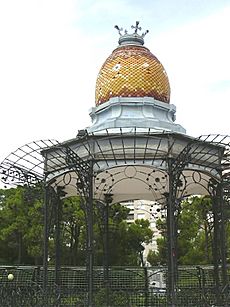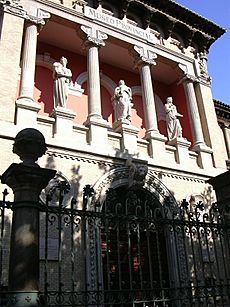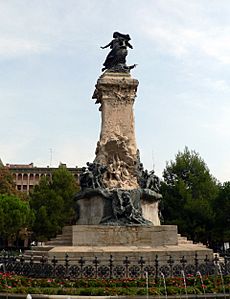Hispano-French Exposition of 1908 facts for kids
The Hispano-French Exposition was a big event, like a world's fair, held in the city of Zaragoza, Spain. It took place from May to December in 1908. The main reason for this event was to celebrate 100 years since the first Siege of Zaragoza in 1808. It aimed to show how modern and lively Zaragoza and the Aragon region were. It also helped strengthen friendly ties between Spain and France after past conflicts.
Contents
History of the Exposition
Why the Exposition Happened
In 1902, the city of Zaragoza decided to celebrate the 100-year anniversary of the siege. They wanted to make this celebration a regular event. A group called the Commemorative Committee of the Siege was created. They planned a large industrial show. However, they weren't sure how big it could be because they didn't have much money.
In 1906, the Spanish government decided to help. They gave 2.5 million pesetas to pay for the exposition. After this, an executive committee for the Exposition was set up. It was led by Basilio Paraíso, a local businessman. Paraíso organized both the centenary celebration and the Exposition. He put Ricardo Magdalena in charge of planning the buildings and layout.
The exposition was seen as a very modern event. Its goal was to show how strong the culture and economy of Zaragoza and Aragon were. It also helped to improve relationships between Spain and its French neighbors. This was important after the Napoleonic Wars that happened in the 1800s.
What Happened at the Event
Not everything was done exactly as Basilio Paraíso wanted. Other important people, like Florencio Jardiel, also had a say. Jardiel was the president of the centenary's organizing committee. His influence could be seen in the importance of the Marine Pavilion and the results of the National Pedagogical Congress.
The exposition was built on land called the Huerta de Santa Engracia. This area is now around the Plaza de los Sitios. About 36,500 workers helped build the projects. These projects were designed by Ricardo Magdalena and other architects.
Magdalena designed the most important buildings. One of them is the Museo Provincial de Zaragoza today. It's a huge palace built in the Neo-Renaissance style, inspired by old Aragonese palaces. He also designed the Gran Casino, a modernist building that was taken down in 1930.
Younger architects designed other buildings. Félix Navarro designed the Escuela de Artes y Oficios, which is still standing in the Plaza de los Sitios. In the middle of the Plaza, the Monumento a los Sitios was built. It was created by Agustí Querol Subirats, a sculptor from Catalonia, in a modernist style. You can still see it there today.
Most of the buildings were modernist and only meant to be temporary. They were built with cheap materials like wood, plaster, and adobe. They were torn down after the Exposition ended. Buildings that were removed included the Theater, the Entrance Gate, the Food Pavilion, the Marian Pavilion, and the Central Pavilion (or French Pavilion). The French Pavilion was built in a neo-Rococo style and had an exciting section about the French car industry.
More than 5,000 exhibitors took part in the event. The most popular exhibits were about agriculture, food, machinery, and manufactured goods. Visitors could also see displays about crafts, health, and chemical products. Both public groups, like the French government, and private companies, like Altos Hornos de Vizcaya, had exhibits. Catalonia also had a big presence.
The exposition also included several other meetings or congresses. These covered topics like science, national agriculture, trade, exports, and tourism. There was also a large art show. It featured both modern art and arte retrospectivo, which means art from the past.
The event was very popular, with more than half a million visitors. Because of this success, the exposition was extended by two months. King Alfonso XIII was one of the famous visitors. He visited the Exposition many times.
What the Exposition Left Behind
Zaragoza hosted another big exposition, Expo 2008, exactly 100 years later. This event also celebrated the 200-year anniversary of the siege. The idea was to make this a special event that happens every 100 years.
See also
 In Spanish: Exposición Hispano-Francesa de 1908 para niños
In Spanish: Exposición Hispano-Francesa de 1908 para niños




